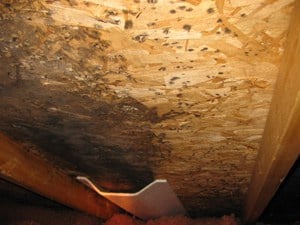 Mould is definitely something you don’t want around your home. Although it’s not poisonous, it is unsightly, puts other people off, and over a period of exposure, could cause chronic, upper respiratory illness too. It’s also the outward sign of water problems, especially in the basement. We’ve been doing mould removal and mitigation for a long time now in and around Toronto, and there is one thing that we know. The source of the water problem needs to be removed before your mould problem can successfully be eliminated.
Mould is definitely something you don’t want around your home. Although it’s not poisonous, it is unsightly, puts other people off, and over a period of exposure, could cause chronic, upper respiratory illness too. It’s also the outward sign of water problems, especially in the basement. We’ve been doing mould removal and mitigation for a long time now in and around Toronto, and there is one thing that we know. The source of the water problem needs to be removed before your mould problem can successfully be eliminated.
Mould Testing Kits
Although some stores still sell these kits, they’re almost useless. Putting out a “settling plate” is about as sensible as leaving a ripe banana out on the kitchen counter. OF COURSE mould will develop naturally on the fruit. That’s what mould does. And it will settle on the settling plate because that’s what it’s designed for too. But this DOES NOT necessarily mean that the mould came from somewhere in your house – or for that matter tell you where it came from either.
Moreover, the decreasing popularity of mould kits also means that they may sit on shelves for ages, even though the testing chemicals have shorter sell-by-dates. Some scientists investigating them have also recorded conflicting findings. This means that mould test kits are `at best, unreliable.
A Total Lack of Logic
Knowing you have mould in your home is a problem statement, and not a solution. And the mould you are concerned about is obviously concealed, or else why would you need to test for it? The far bigger risk you run by using a mould testing kit is that you might get a clear result, while all the time intruding water is causing permanent damage to the structure of your home.
Manufacturers of the test kits know this. That’s why they use scare tactics like “mould could potentially kill you”, when it’s patently not true. Mould, inhaled over a period of time, or if you have respitory problems, can be dangerous, but it’s still not poison.We’ll say it one more time so there’s no possibility of misunderstanding. Mould is not the problem. It’s the dampness and leaking water behind the mould you should be worrying about.
Damp Inspections versus Mould Tests
Every basement should be inspected annually for dampness and other wet basement problems. That’s because basements attract moisture the same way overripe bananas attract mould. A mould test kit is a blind test for fungi that tells you virtually nothing. You’re just wasting time and money.
A damp inspection, on the other hand, is a detailed survey of your entire home by specialists who know just where to look for problems. If there’s mould there too, they’ll be sure to spot it. This information is secondary in nature though, and it effectively comes free.
Choosing the Right Basement Specialist
Although the internet is cluttered with information about damp and mould, this is no more useful than background static, because there’s no substitute for training and experience. Sourcing and addressing damp problems – especially in basements – is no job for casual handymen with mould test kits. If you have signs of water problems and mould in your home, the best bet is to have a certified professional come in and do a full inspection in your home.













